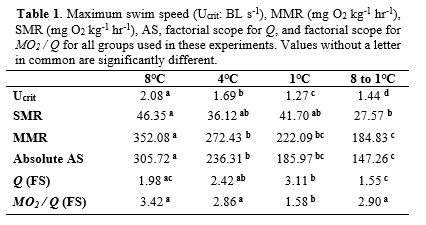CARDIORESPIRATORY FUNCTION AND SWIMMING CAPACITY OF ATLANTIC SALMON Salmo salar AT COLD TEMPERATURES
The severity and frequency of challenging environmental conditions, such as marine heat waves, storms, hypoxia and extreme reductions in water temperature, continue to increase as a result of climate change. However, most literature on the in vivo physiological impacts of climate change on cultured fish species, including Atlantic salmon, is limited to the warm end of temperatures that this species can be exposed to in culture (i.e., 18-23oC). Temperatures at cage-sites in Atlantic Canada can also be 0-2? for days to months at a time in the winter. Thus, it is crucial to understand how these temperatures affect the cardiorespiratory function, bioenergetics and swimming performance of salmon.
Mixed sex salmon (~ 675 g) were acclimated to 8, 4 or 1? in seawater, or acutely cooled (from 8-1? overnight), and changes in aerobic metabolism and cardiac function were measured during a critical swim speed (Ucrit) test. Swimming capacity (Ucrit) decreased by ~ 40%, and maximum metabolic rate (MMR) and aerobic scope [AS; MMR – standard metabolic rate (SMR)] were ~50% lower, for fish tested at 1 vs. 8oC (with values for 4oC acclimated fish intermediate between these values). Interestingly, fish acclimated to 1? had a lower Ucrit value than fish acutely exposed to this temperature, despite having statistically similar values for MMR, AS and anaerobic capacity (measured as post-exercise lactate levels). This suggests that factors independent of oxygen delivery, such as muscle contractile performance, may limit the swimming capacity of salmon when chronically exposed to temperatures approaching their lower thermal limit.
Fish tested at 8 and 4? had the capacity to increase cardiac output (Q) and tissue oxygen extraction (MO2 / Q) to meet the metabolic demand of increased performance. However, fish tested at 1? were only capable of increasing one of these parameters. Fish acclimated to 1? had a high resting MO2 / Q and low Q (i.e., a high scope for
Q), whereas fish acutely exposed to 1? had a high resting Q and low MO2 / Q (i.e., a high scope for MO2 / Q). These data suggest that salmon do not have the ability to increase both parameters when exposed to 1? and are interesting with respect to how acute vs. chronic exposure to cold temperatures affect the salmon’s phenotypic plasticity in the context of supporting oxygen delivery during exercise.
Overall, these data show that the Atlantic salmon’s metabolic and swimming capacity decrease considerably as water temperature is lowered to near 0oC, and suggest that this may make it difficult for them survive if challenged with other suboptimal conditions or stressful events.
